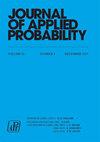Bivariate tempered space-fractional Poisson process and shock models
IF 0.7
4区 数学
Q3 STATISTICS & PROBABILITY
引用次数: 0
Abstract
We introduce a bivariate tempered space-fractional Poisson process (BTSFPP) by time-changing the bivariate Poisson process with an independent tempered双变量节制空间分数泊松过程和冲击模型
我们引入了双变量有节制空间分数泊松过程(BTSFPP),即用独立的有节制 $\alpha$ - 稳定从量对双变量泊松过程进行时变。我们研究了它的分布特性及其与微分方程的联系。我们还推导出了 BTSFPP 的 Lévy 度量。我们还探讨了一个基于 BTSFPP 的双变量竞争风险和冲击模型,用于预测经历两次随机冲击的物品的失效时间。当两种冲击的总和达到某个随机阈值时,系统就会崩溃。我们研究了与可靠性有关的各种结果,如可靠性函数、危险率、失效密度和因某类冲击而发生失效的概率。我们证明,对于一般的莱维从属器,当阈值具有几何分布时,系统的失效时间呈指数分布,其均值取决于莱维从属器的拉普拉斯指数。我们还展示了一些特例和几个典型例子。
本文章由计算机程序翻译,如有差异,请以英文原文为准。
求助全文
约1分钟内获得全文
求助全文
来源期刊

Journal of Applied Probability
数学-统计学与概率论
CiteScore
1.50
自引率
10.00%
发文量
92
审稿时长
6-12 weeks
期刊介绍:
Journal of Applied Probability is the oldest journal devoted to the publication of research in the field of applied probability. It is an international journal published by the Applied Probability Trust, and it serves as a companion publication to the Advances in Applied Probability. Its wide audience includes leading researchers across the entire spectrum of applied probability, including biosciences applications, operations research, telecommunications, computer science, engineering, epidemiology, financial mathematics, the physical and social sciences, and any field where stochastic modeling is used.
A submission to Applied Probability represents a submission that may, at the Editor-in-Chief’s discretion, appear in either the Journal of Applied Probability or the Advances in Applied Probability. Typically, shorter papers appear in the Journal, with longer contributions appearing in the Advances.
 求助内容:
求助内容: 应助结果提醒方式:
应助结果提醒方式:


